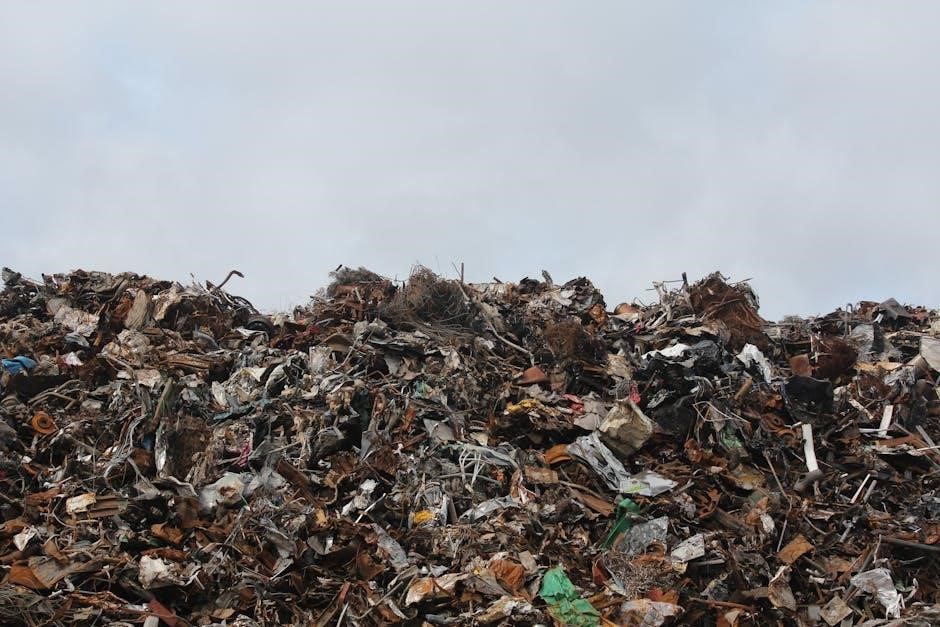
Learning scrap metal identification is crucial for recycling and business, using
various methods
and tools to identify metals, with online guides and charts available to help navigate the process effectively every day.
Importance of Proper Identification
Proper identification of scrap metals is essential for efficient recycling and business operations, as it enables the separation of valuable metals from less valuable ones, maximizing profits and minimizing losses; The importance of proper identification cannot be overstated, as incorrect identification can lead to contamination of metal streams, resulting in decreased quality and value of the final product. Furthermore, proper identification also ensures compliance with regulatory requirements and industry standards, reducing the risk of non-compliance and associated penalties. By accurately identifying scrap metals, businesses can optimize their operations, improve efficiency, and increase revenue. This, in turn, contributes to a more sustainable and environmentally friendly metal recycling industry, which is critical for conserving natural resources and reducing waste. Effective scrap metal identification is, therefore, a critical component of a successful metal recycling operation, and its importance should not be underestimated. Proper identification is key to a well-run operation.
Overview of the Identification Process
The identification process involves a series of steps, including visual inspection, testing, and analysis, to determine the type and composition of scrap metals. This process typically begins with a visual examination of the metal’s appearance, including its color, texture, and shape. The metal is then subjected to various tests, such as magnetic, chemical, and physical tests, to determine its properties and characteristics. The results of these tests are used to identify the metal and determine its value and potential uses. The identification process may also involve the use of specialized equipment, such as spectrometers and analyzers, to provide more detailed information about the metal’s composition. By following a systematic and thorough identification process, scrap metal recyclers can ensure accurate and reliable results, which is essential for efficient and profitable operations. The process is critical to the success of metal recycling and requires careful attention to detail and a thorough understanding of metal properties.

Methods of Scrap Metal Identification
Various methods are used to identify scrap metals, including testing and analysis, with online guides and charts available to help navigate the process effectively every single day always.
Magnet Test for Ferrous and Non-Ferrous Metals
The magnet test is a simple and effective method for identifying ferrous and non-ferrous metals, with a magnet being used to determine if a metal is ferrous or non-ferrous. This test is based on the principle that ferrous metals are attracted to magnets, while non-ferrous metals are not; The magnet test is a crucial step in the scrap metal identification process, as it allows for the separation of ferrous and non-ferrous metals. By using a magnet to test the metal, individuals can quickly determine whether the metal is ferrous or non-ferrous, and then proceed with further testing and analysis to determine the specific type of metal. The magnet test is a widely used and reliable method for identifying scrap metals, and is an essential tool for anyone involved in the scrap metal industry. The test is easy to perform and requires minimal equipment, making it a convenient and cost-effective method for identifying scrap metals.
Chemical Spot Tests for Metal Identification

Chemical spot tests are a valuable tool for identifying specific types of metals, particularly when used in conjunction with other testing methods. These tests involve applying a chemical reagent to a small sample of the metal, and observing the resulting reaction. The reaction can indicate the presence of specific elements or compounds, allowing for the identification of the metal. Chemical spot tests can be used to identify ferrous and non-ferrous metals, as well as to distinguish between different types of metals. The tests are relatively simple to perform, and can be done with minimal equipment. A chart of chemical spot tests for certain metals and alloys can be used to guide the testing process and ensure accurate results. By using chemical spot tests, individuals can gain a better understanding of the composition and properties of the metal, and make informed decisions about its use or disposal. This information is essential for effective metal identification and recycling.

Tools and Equipment for Scrap Metal Identification
Handheld testers and analyzers are essential tools for identifying scrap metals quickly and accurately every day.
Handheld Scrap Metal Testers and Analyzers
Handheld scrap metal testers and analyzers are portable devices used to identify and analyze scrap metals. These devices use various technologies such as X-ray fluorescence or optical emission spectroscopy to determine the chemical composition of the metal. They are designed to be easy to use and provide accurate results in a matter of seconds. The use of handheld testers and analyzers has become increasingly popular in the scrap metal industry due to their convenience and accuracy. They are commonly used by scrap metal dealers, recyclers, and collectors to identify and sort metals quickly and efficiently. By using these devices, individuals can ensure that they are getting the correct price for their scrap metals and can also help to reduce the risk of contamination. Overall, handheld scrap metal testers and analyzers are an essential tool for anyone involved in the scrap metal industry. They provide a fast and accurate way to identify and analyze scrap metals, making them a valuable asset for any business or individual.
Scrap Metal Identification Charts and Guides
Scrap metal identification charts and guides are essential tools for identifying and sorting scrap metals. These charts and guides provide a comprehensive list of metals, their properties, and characteristics, making it easier to identify and distinguish between different types of metals. They are often used in conjunction with other identification methods, such as the magnet test and chemical spot tests. The charts and guides are typically organized by metal type, with detailed descriptions and images to help users identify the metals. They are available in various formats, including online databases, mobile apps, and printed manuals. By using these charts and guides, individuals can improve their knowledge of scrap metals and make more accurate identifications. This can help to increase efficiency and profitability in the scrap metal industry. The use of scrap metal identification charts and guides is a crucial step in the identification process, and they are widely used by scrap metal dealers, recyclers, and collectors.

Common Types of Scrap Metals
Identifying metals like copper, aluminum, and steel using
various techniques
is essential for recycling and business purposes daily.
Ferrous Metals like Iron and Steel
Ferrous metals, including iron and steel, are commonly found in scrap metal and can be recycled. These metals are widely used in construction, manufacturing, and other industries. The identification of ferrous metals is crucial for recycling purposes, as they can be separated from non-ferrous metals using a magnet. Iron and steel are highly recyclable and can be reused in various applications. The recycling process involves collecting, sorting, and processing ferrous metals to produce new products. This helps to conserve natural resources, reduce waste, and decrease the environmental impact of metal production. Ferrous metals like iron and steel are valuable resources that can be recycled repeatedly without losing their properties. By identifying and recycling these metals, we can reduce the need for virgin materials and promote sustainable development. The use of ferrous metals in recycling also helps to reduce greenhouse gas emissions and mitigate climate change. Overall, the identification and recycling of ferrous metals play a vital role in promoting environmental sustainability and conserving natural resources.
Non-Ferrous Metals like Copper and Aluminum
Non-ferrous metals, such as copper and aluminum, are highly valued in the scrap metal industry due to their high demand and recyclability. These metals are widely used in various! applications, including electrical wiring, electronics, and packaging. Copper is a highly conductive metal, making it ideal for electrical applications, while aluminum is lightweight and corrosion-resistant, making it suitable for packaging and transportation. The identification of non-ferrous metals is crucial for recycling purposes, as they can be separated from ferrous metals using various methods. Non-ferrous metals like copper and aluminum can be recycled repeatedly without losing their properties, making them a valuable resource. The recycling of these metals helps to conserve natural resources, reduce waste, and decrease the environmental impact of metal production. By identifying and recycling non-ferrous metals, we can promote sustainable development and reduce the need for virgin materials. The demand for these metals is high, making them a valuable commodity in the scrap metal industry.